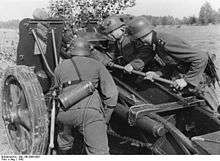15 cm sIG 33
| 15 cm sIG 33 | |
|---|---|
|
A sIG 33 at the Belgrade Military Museum, Serbia | |
| Type | Heavy infantry gun |
| Place of origin | Weimar Republic |
| Service history | |
| In service | 1927-1945 |
| Used by | Nazi Germany |
| Wars | World War II |
| Production history | |
| Designer | Rheinmetall |
| Designed | 1927–33 |
| Manufacturer | Rheinmetall, AEG-Fabriken, Bohemisch Waffenfabrik |
| Produced | 1936–1945 |
| No. built | around 4,600 |
| Variants | sIG 33/1 |
| Specifications | |
| Weight | 1,800 kg (4,000 lb) |
| Length | 4.42 m (14 ft 6 in) |
| Barrel length | 1.65 m (5 ft 5 in) L/11 |
| Width | 2.06 m (6 ft 9 in) |
|
| |
| Shell | cased separate-loading (6 charges) |
| Caliber | 149.1 mm (5.87 in) |
| Breech | horizontal sliding block |
| Recoil | hydropneumatic |
| Carriage | box trail |
| Elevation | 0° to +73° or -4° to +75° |
| Traverse | 11.5° |
| Rate of fire | 2-3 rounds per minute |
| Muzzle velocity | 240 m/s (790 ft/s) (HE) |
| Effective firing range | 4,700 m (5,100 yd) |
| Sights | Rblf36 |
The 15 cm sIG 33 (schweres Infanterie Geschütz 33) was the standard German heavy infantry gun used in the Second World War. It was the largest weapon ever classified as an infantry gun by any nation.[1]
Sources differ on the development history, but the gun itself was of conventional design. Early production models were horse-drawn, with wooden wheels. Later production models had pressed steel wheels, with solid rubber tires and air brakes for motor towing.
The sIG 33 was rather heavy for its mission, and it was redesigned in the late 1930s to incorporate light alloys. This saved about 150 kilograms (330 lb), but the outbreak of war forced the return to the original design before more than a few hundred were made, as the Luftwaffe had a higher priority for light alloys. A new carriage, made entirely of light alloys, was tested around 1939, but was not accepted for service.

Ammunition
Most of the shells used by the sIG 33 were unexceptional in design, but the Stielgranate 42 was different in fundamental ways from ordinary shells. The driving rod was loaded into the muzzle so that the finned projectile remained in front of, and outside, the barrel entirely. A special charge was loaded and would propel the projectile about 1,000 metres (1,100 yd). At about 150 metres (160 yd) distance, the driving rod would separate from the projectile. Unlike other Stielgranaten, this version was not intended for anti-tank use, but rather for the demolition of strongpoints and clearing barbed-wire obstacles and minefields by blast effect.
| Shell | Type | Weight | Filler |
|---|---|---|---|
| I Gr 33 | HE | 38 kilograms (84 lb) | 8.3 kilograms (18 lb) amatol |
| I Gr 38 Nb | Smoke | 40 kilograms (88 lb) | oleum/pumice |
| I Gr 39 Hl/A | Hollow-charge | 25.5 kilograms (56 lb) | cyclonite/TNT |
| Stielgranate 42 | Demolition | 90 kilograms (200 lb) | 27 kilograms (60 lb) amatol |
See also
Notes
- ↑ Hogg, p. 26
References
| Wikimedia Commons has media related to 15 cm sIG 33. |
- Chamberlain, Peter, and Hilary L. Doyle. Thomas L. Jentz (Technical Editor). Encyclopedia of German Tanks of World War Two: A Complete Illustrated Directory of German Battle Tanks, Armoured Cars, Self-propelled Guns, and Semi-tracked Vehicles, 1933–1945. London: Arms and Armour Press, 1978 (revised edition 1993). ISBN 1-85409-214-6
- Engelmann, Joachim and Scheibert, Horst. Deutsche Artillerie 1934-1945: Eine Dokumentation in Text, Skizzen und Bildern: Ausrüstung, Gliederung, Ausbildung, Führung, Einsatz. Limburg/Lahn, Germany: C. A. Starke, 1974
- Gander, Terry and Chamberlain, Peter. Weapons of the Third Reich: An Encyclopedic Survey of All Small Arms, Artillery and Special Weapons of the German Land Forces 1939-1945. New York: Doubleday, 1979 ISBN 0-385-15090-3
- Hogg, Ian V. German Artillery of World War Two. 2nd corrected edition. Mechanicsville, PA: Stackpole Books, 1997 ISBN 1-85367-480-X
- Trojca, Waldemar and Jaugitz, Markus. Sturmtiger and Sturmpanzer in Combat. Katowice, Poland: Model Hobby, 2008 ISBN 978-83-60041-29-1
- Infanteriegeschütze : lexikon-der-wehrmacht.de (German)
- 15-cm Heavy Infantry Howitzer, German Infantry Weapons, Military Intelligence Service, Special Series No. 14, May 25, 1943.
